- | 4:00 pm
This futuristic office was designed for 5,000 people—and 100 robot coworkers
This new building by Korean tech giant Naver was designed to experiment with the future of automation.

From the outside, the building resembles a 28-story robot hive—an anonymous box of metal and vents. And that’s exactly what it is.
Dubbed 1784, this is the new headquarters for Naver Labs, opening in June. Owned by Naver, which you might consider the Google of South Korea, it’s “the world’s first robot-friendly building,” according to the company.
Architected by Samsung subsidiary Samoo, it’s a space designed to test the boundaries of the future of automation, where 100 wheeled robots will soon work alongside 5,000 people, ferrying packages, lunches, and Starbucks coffee to their human counterparts. These robots aren’t just a gimmick, but an extension of the building architecture itself, serving as a way to give the building hands today while it learns how to take care of itself tomorrow.
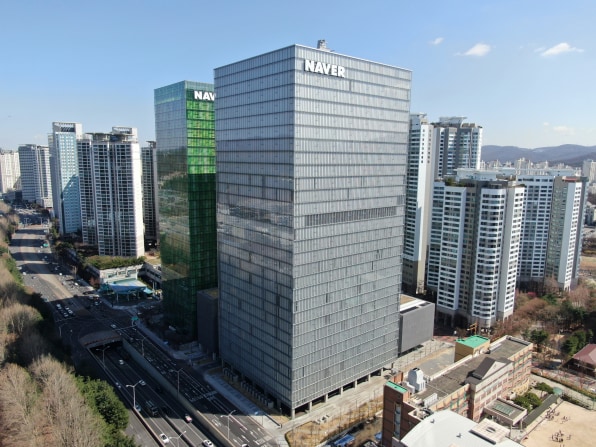
[Photo: Naver]
As Sangok Seok, CEO of Naver Labs, explains, 1784 (named for both its street address and because 1784 marked the start of the Industrial Revolution) was never intended to be a building for robots.
“We just wanted to build a normal office building,” Seok says. But as the company considered its role in the future, its vision grew more ambitious. Naver is the leading search engine in South Korea, but much like the U.S.’s own tech companies, that’s only a sliver of its services: Like Amazon, Naver sells products and operates a sizable cloud business. Like Microsoft, it researches AI and robotics. Oh, and Naver also runs a messaging app, social media platform, and comic book service on top of its burgeoning robot business.
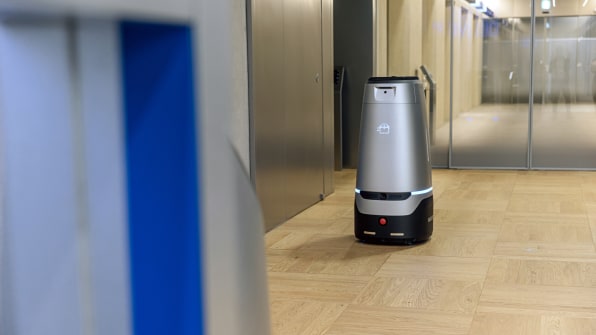
[Photo: Naver]
The vision for 1784 became what the company calls a “test bed” for creating a world where all of these services come together, a living experiment where Naver Labs’s designers and engineers cohabitate with their own products. (To prove the point, Seok pulls out his phone during our chat, loads the Naver app, and uses it to open the louvers blocking the sun outside his own window.)But the most important part of those products may very well be the robot itself. Named Rookie, it’s a robot purpose-built by Naver for this building, as the company has been creating many of the foundational technologies and designing the UX to bring the vision to life. And at 1784, their function is designed to weave into the architecture.
“[Robots] weren’t Naver’s business at all in the beginning . . . but we thought perhaps it could be a new type of business unto itself,” Seok says, alluding to the opportunities in an industry poised to reach $116 billion by 2030.
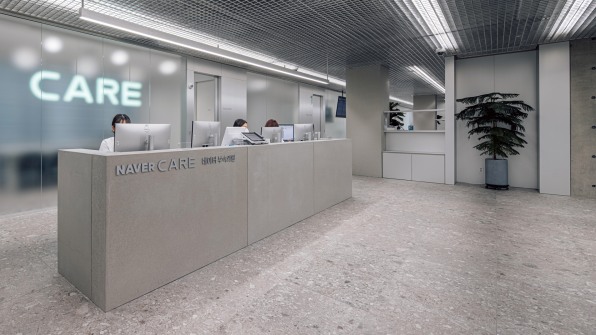
[Photo: Naver]
A BUILDING FOR ROBOTS, INSPIRED BY PEOPLE WITH DISABILITIES
The defining motifs of 1784 can be seen in their spartan fit and finish. Steel and concrete dominate the space to invoke the sensation of futurism, which is warmed with occasional wood floors and the incorporation of greenery.
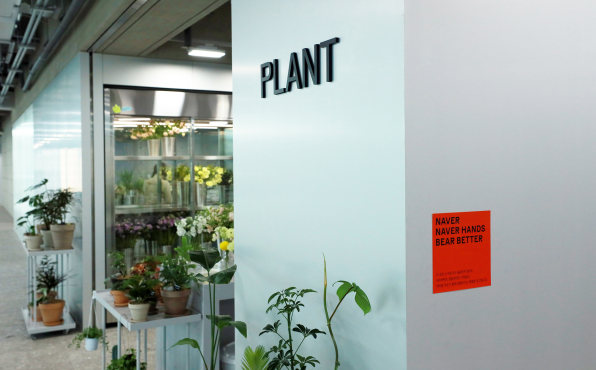
[Photo: Naver]
“Thanks to all the plants we have within the building, it doesn’t feel necessarily too cold or inhumane,” Seok insists.
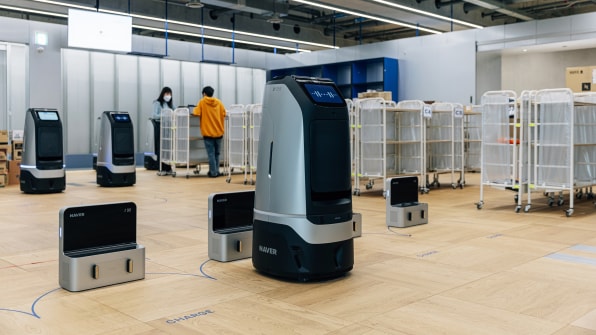
[Photo: Naver]
To accommodate Rookie—which stands about 3 feet tall and more than a foot wide—the team was inspired by existing standards around people with disabilities. They knew that bipedal robots that walk around like people are still a way off, and that their robots would need to drive on wheels.Coincidentally, many of Naver’s concerns for how robots might traverse the space without falling over were already solved with design for wheelchair accessibility. That means the building never requires Rookie to take the stairs, features wide halls, and avoids hard slopes or single steps.
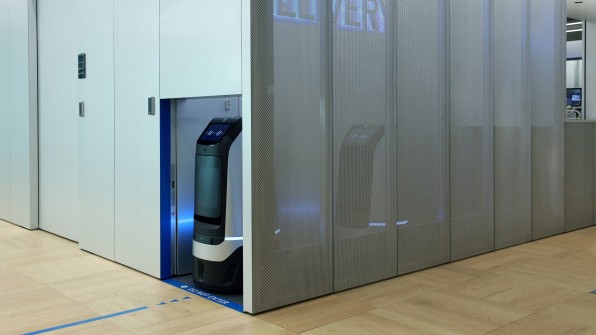
[Photo: Naver]
Rookie is loaded with packages—shipments, food, or coffee—by hand. To deliver this cargo up and down floors, robots can pull into the 36 human elevators if necessary. But during times like the lunch rush, a crowded elevator would be tricky for a robot to navigate. Instead, Naver built a robot-exclusive elevator called the Roboport. Through a short door that’s only about 4 feet tall, robots can enter a loop of small cars that continually rotate through the building, kind of like an internal Ferris wheel.
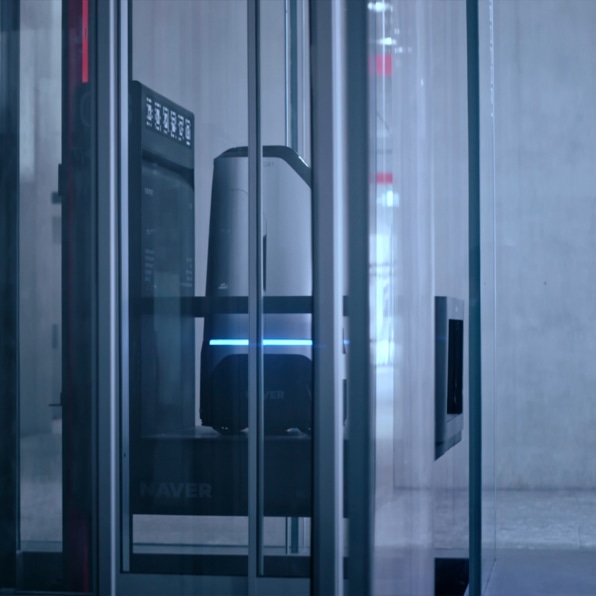
[Photo: Naver]
That solves getting floor to floor, but how does a robot even know how to navigate toward the right elevator to begin with? That’s handled by the unique design of Rookie itself. Every robot is actually controlled not by its own brain but by the cloud—like a queen directing her colony.
A VERY SMART, DUMB ROBOT DESIGN
As Seok explains, we imagine most robots as self-contained, intelligent devices with their own processors and navigational tools, much how autonomous Waymo cars use lidar to map streets in 3D. But Naver’s robots are “brainless,” and make their way through 1784 primarily using a normal video camera.
How is this possible? Because Naver has moved the vast majority of each robot’s processing to servers. Using the building’s own internal 5G network, which Naver was able to deploy only with special permission from the government, Naver servers guide robots through the building with less latency than Wi-Fi.
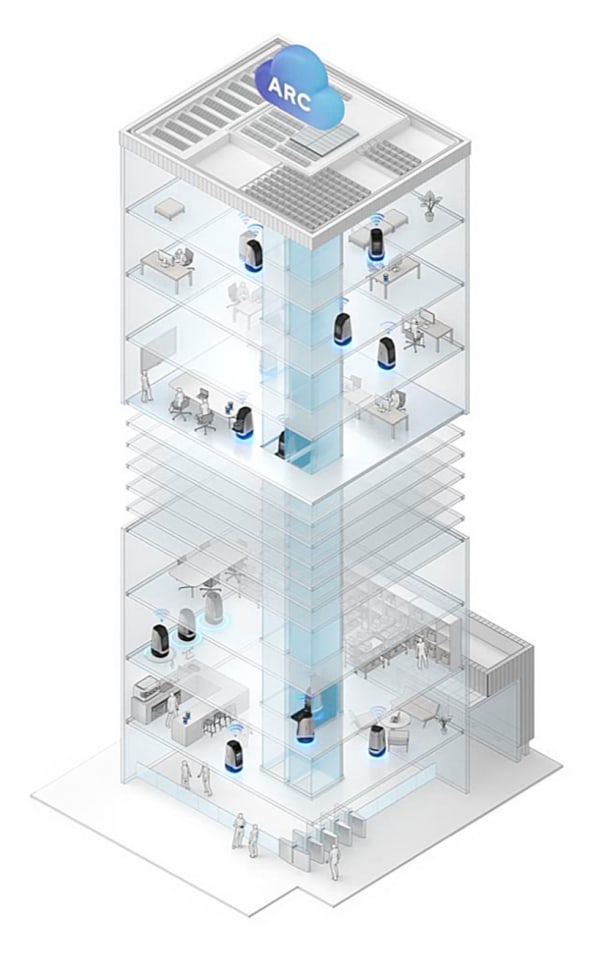
[Photo: Naver]
“[The lag] is so short that the robot actually thinks the brain is in it rather than somewhere else,” Seok says. “In such a large building, we do believe in the need for a central control system for harmonious and smart control for 100 robots to move—we have to manage that properly.”To help the robots navigate, Naver servers hold a “digital twin,” or a 3D scan of the rooms and hallways inside 1784. By cross-referencing the twin with the robot’s own camera feed, the system can place robots with 6-inch accuracy at any given moment.
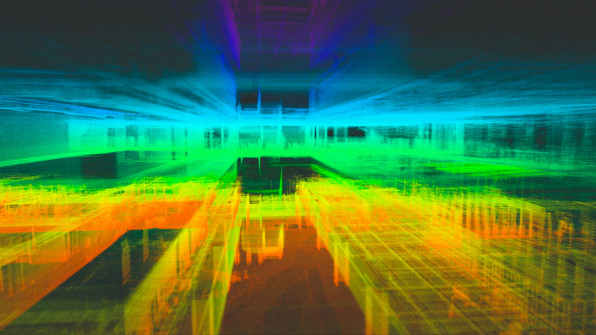
[Photo: Naver]
The robots understand to drive on the right side of the hallway with the flow of human walkers, but choreographing exactly how they drive through the halls alongside other people is something that Naver is still perfecting (and is ripe for social sabotage, if you understand their logic). Seok laughs as he tells me how he was able to trick four of the robots into bumping into one another as a prank on the engineering team.
But Rookie isn’t simply an engineering challenge for the company: The soft touch points of these robots matters, too. Rookie has eyes that gaze in the direction it’s going, so that people can better read its intent. It also emanates a low artificial whir as it drives so that people can hear it coming.
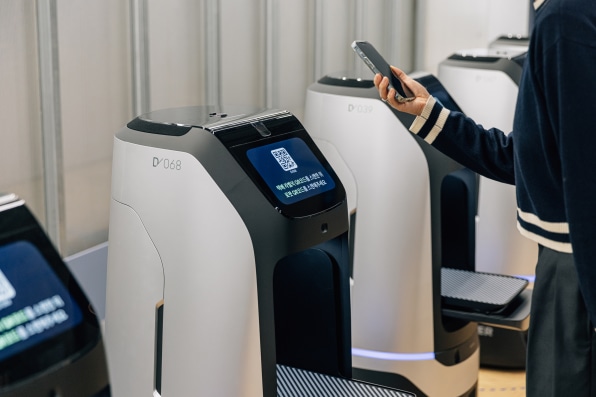
[Photo: Naver]
Whenever Rookie makes a delivery, it scans the person’s face first to make sure they’re the right recipient. Then the lid opens to reveal the parcel. But even this moment is particular—designed to feel “like how a Mercedes car door would open,” says Seok, while a sensor inside can spot your hand so that the door never clamps shut on it.
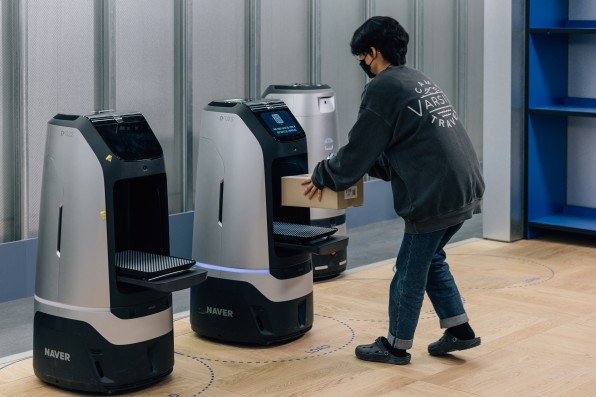
[Photo: Naver]
“Every day, these little details are added to these robots,” Seok says, noting that over time, he hopes that other Korean companies will take interest in Naver’s work and reach out to build similar robotic offices. Perhaps that all sounds a bit dystopian. Working alongside robots? Who wants to do that? And yet Seok says that in his own experience, he gets the sensation that Rookie is there for him.
“As a person working in this building, I can feel that it’s not just about the robots, but the people—and the robots and services are meant for the people,” Seok says. “The whole dynamic of the human-robot interaction is very cute. [Rookie is] smiling at you . . . rather than feeling cold in context, it does feel pretty fun.”
Meanwhile, for its next act, Naver is developing new robots that can monitor the Naver cloud. They will be designed to lift these computers in racks and handle many of the day-to-day operations of managing servers.
“It is quite funny because, as you know, the robot’s brain is in essence there in the server,” Seok says, “and so the robot is looking after its own brain.”




































